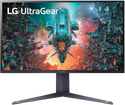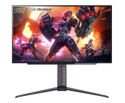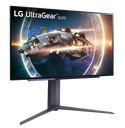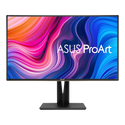A comparison of specs, key information, reviews, and best pricing from top retailers
Last updated -- hours ago | Report incorrect information
What we think

The PerfectRec monitor team Learn more
Updated April 22, 2024·
The Asus PG27AQN, being less expensive, offers a strong competitive gaming experience with a high refresh rate and very good response time, making it suitable for fast-paced games. However, it has a lower contrast and brightness, and limited color performance, which makes it less ideal for HDR gaming and media consumption. The Samsung Odyssey OLED G9, while more expensive, provides exceptional contrast and color performance with a larger and wider screen, making it excellent for immersive gameplay and watching videos. It's also great for HDR content, but due to its lower pixels per inch, image clarity might not be as sharp as the Asus for productivity tasks. Give Feedback
this description is based on the product variant with some specs and product variant with some specs. At the time of writing, the variant with some specs cost some dollars and the variant with some specs cost some dollars.
Advantages of the Asus PG27AQN (IPS)
- Best in class for competitive gaming
- Best in class refresh rate
- Good text clarity
- Good image clarity
Advantages of the Samsung Odyssey OLED G9 G93SC (QD-OLED)
- Best in class for casual gaming
- Best in class for media consumption
- Best in class contrast
- Best in class brightness
- Best in class color volume
- Best in class response time
Key differences
Casual Gaming
6.7


9.9
2560 x 1440
RESOLUTION
5120 x 1440
360Hz
REFRESH RATE
240Hz
974:1
NATIVE CONTRAST
Inf:1
414 nits
SDR PEAK BRIGHTNESS
1000 nits
644 nits
HDR PEAK BRIGHTNESS
Unknown
92.0 %
DCI-P3 COLOR GAMUT
98.0 %
Semi-Gloss
COATING
Glossy
The Samsung Odyssey OLED G9 G93SC (QD-OLED) is best in class for casual gaming, while the Asus PG27AQN (IPS) is only fair.
Competitive Gaming
9.5


6.7
360Hz
REFRESH RATE
240Hz
5.6 ms
TOTAL RESPONSE TIME
0.0 ms
20 - 360 Hz
VARIABLE REFRESH RATE
48 - 240 Hz
Yes
STROBING / BFI
No
414 nits
SDR PEAK BRIGHTNESS
1000 nits
The Asus PG27AQN (IPS) is best in class for competitive gaming, while the Samsung Odyssey OLED G9 G93SC (QD-OLED) is only fair.
Productivity
6.5


5.9
2560 x 1440
RESOLUTION
5120 x 1440
109 PPI
PIXELS PER INCH
108 PPI
Yes
ADJUSTABLE STAND
Yes
Semi-Gloss
COATING
Glossy
The Asus PG27AQN (IPS) is only fair for productivity, while the Samsung Odyssey OLED G9 G93SC (QD-OLED) is poor.
Media Consumption
6.0


9.8
2560 x 1440
RESOLUTION
5120 x 1440
974:1
NATIVE CONTRAST
Inf:1
414 nits
SDR PEAK BRIGHTNESS
1000 nits
644 nits
HDR PEAK BRIGHTNESS
Unknown
Semi-Gloss
COATING
Glossy
The Samsung Odyssey OLED G9 G93SC (QD-OLED) is best in class for media consumption, while the Asus PG27AQN (IPS) is only fair.
HDR Gaming and Media Consumption
No


Yes
The Asus PG27AQN (IPS) is not suitable for HDR gaming and media consumption while the Samsung Odyssey OLED G9 G93SC (QD-OLED) is suitable for HDR gaming and media consumption.
Digital Photo Editing
No


Yes
The Asus PG27AQN (IPS) is not suitable for digital photo editing while the Samsung Odyssey OLED G9 G93SC (QD-OLED) is suitable for digital photo editing.
HDR Video Editing and Color Grading
No


Yes
The Asus PG27AQN (IPS) is not suitable for HDR video editing and color grading while the Samsung Odyssey OLED G9 G93SC (QD-OLED) is suitable for HDR video editing and color grading.
Print Photo Editing
No


Yes
The Asus PG27AQN (IPS) is not suitable for print photo editing while the Samsung Odyssey OLED G9 G93SC (QD-OLED) is suitable for print photo editing.
Key similarities
Cost
$949


$965
$400
$600
$800
$1,000
$1,200
$1,400
$1,600
The Asus PG27AQN (IPS) has a price of $949 and the Samsung Odyssey OLED G9 G93SC (QD-OLED) costs $965.
Give feedback
We’re constantly working to improve.
How the Asus PG27AQN (IPS) and the Samsung Odyssey OLED G9 G93SC (QD-OLED) compare to other monitors
Spec Comparison
| Asus PG27AQN (IPS) | Samsung Odyssey OLED G9 G93SC (QD-OLED) |
GENERAL | |||
|---|---|---|---|
| Price | |||
$949 | $965 | ||
Screen Size | |||
Screen Size | 27" | 49" | |
Resolution | |||
Resolution | 2560 x 1440 | 5120 x 1440 | |
Screen Type | |||
Screen Type | LED | OLED | |
Screen Sub-type | |||
Screen Sub-type | IPS | QD-OLED | |
Local Dimming Zones | |||
Local Dimming Zones | 32 | N/A | |
COLOR, CONTRAST & BRIGHTNESS | |||
|---|---|---|---|
Native Contrast | |||
Native Contrast | 974:1 | Inf:1 | |
SDR Peak Brightness | |||
SDR Peak Brightness | 414 nits | 1000 nits | |
HDR Peak Brightness | |||
HDR Peak Brightness | 644 nits | Unknown | |
Suitable for HDR Gaming and Media Consumption | |||
Suitable for HDR Gaming and Media Consumption | No | Yes | |
sRGB Color Gamut | |||
sRGB Color Gamut | 98.5 % | 100 % | |
MOTION CHARACTERISTICS | |||
|---|---|---|---|
Total Response Time | |||
Total Response Time | 5.6 ms | 0.03 ms | |
Variable Refresh Rate | |||
Variable Refresh Rate | 20 - 360 Hz | 48 - 240 Hz | |
Strobing / BFI | |||
Strobing / BFI | Yes | No | |
Persistence Blur Score | |||
Persistence Blur Score | 9.5/10 | 8/10 | |
Ghosting Score | |||
Ghosting Score | 8.1/10 | 10/10 | |
TEXT & IMAGE CLARITY | |||
|---|---|---|---|
Pixels Per Inch | |||
Pixels Per Inch | 109 PPI | 108 PPI | |
Coating | |||
Coating | Semi-Gloss | Glossy | |
Text Clarity Score | |||
Text Clarity Score | 7/10 | 6.6/10 | |
Image Clarity Score | |||
Image Clarity Score | 7/10 | 7/10 | |
PORTS & CONNECTIVITY | |||
|---|---|---|---|
HDMI 1.4 Ports | |||
HDMI 1.4 Ports | 0 | 0 | |
HDMI 2.0 Ports | |||
HDMI 2.0 Ports | 3 | 0 | |
HDMI 2.1 Ports | |||
HDMI 2.1 Ports | 0 | 1 | |
Micro HDMI Ports | |||
Micro HDMI Ports | 0 | 1 | |
DisplayPort 1.2 Ports | |||
DisplayPort 1.2 Ports | 0 | 0 | |
Shopping
Asus PG27AQN (IPS)
See more
Dig into reviews and images
IGN
Matthew Smith | March 2023
"The Asus ROG Swift PG27AQN is a motion clarity marvel. It’s the first 27-inch 1440p 360Hz monitor on the market, and also the first to use an Ultrafast IPS display. These advancements provide outstanding motion clarity across a broad range of refresh rates. Unfortunately, the monitor’s motion clarity does nothing for its image quality, which is just ok. To be clear, it’s a very nice looking monitor in many situations. However, the monitor’s contrast ratio is rather low. And while it can reach high levels of brightness in HDR, it lacks the nuance and contrast required to look great in HDR games."
Give feedback
We're constantly perfecting our model
More comparisons for you
Compare Asus PG27AQN (IPS) vs. MSI MPG 321URX (QD-OLED) VS
VS


Compare Asus PG27AQN (IPS) vs. LG 32GQ950 (IPS) VS
VS


Compare Asus PG27AQN (IPS) vs. LG 27GR95QL (W-OLED) VS
VS


Compare Samsung Odyssey OLED G9 G93SC (QD-OLED) vs. Samsung S43CG70 (VA Mini LED) VS
VS


Compare Samsung Odyssey OLED G9 G93SC (QD-OLED) vs. LG 27GR95QE (W-OLED) VS
VS


Compare Samsung Odyssey OLED G9 G93SC (QD-OLED) vs. Asus PA329C (IPS) VS
VS


FAQs
Why trust us
This information was produced and vetted by the PerfectRec monitors team. We are a product research and recommendation organization that meticulously reviews and evaluates the latest monitor information and makes it digestible for you.
By the numbers
210
Monitors evaluated
10,500
Monitors stats compiled
15
Proprietary Monitors ratings developed
160,700
Recommendations made
24,105
Consumer hours saved
About the monitor team
Joe Golden, Ph.D
CEO and Monitors Editor
Joe is an entrepreneur and lifelong electronics enthusiast with a Ph.D in Economics from the University of Michigan.
Jason Lew
Staff Expert & Software Engineer
Jason is a staff expert and software engineer that has been making laptop recommendations for 7 years and moderates one of the largest laptop subreddits.
Chandradeep Chowdhury
Staff Expert & Software Engineer
Chandradeep is a staff expert and software engineer and expert in televisions and monitors. He’s been making monitor recommendations for ten years.







